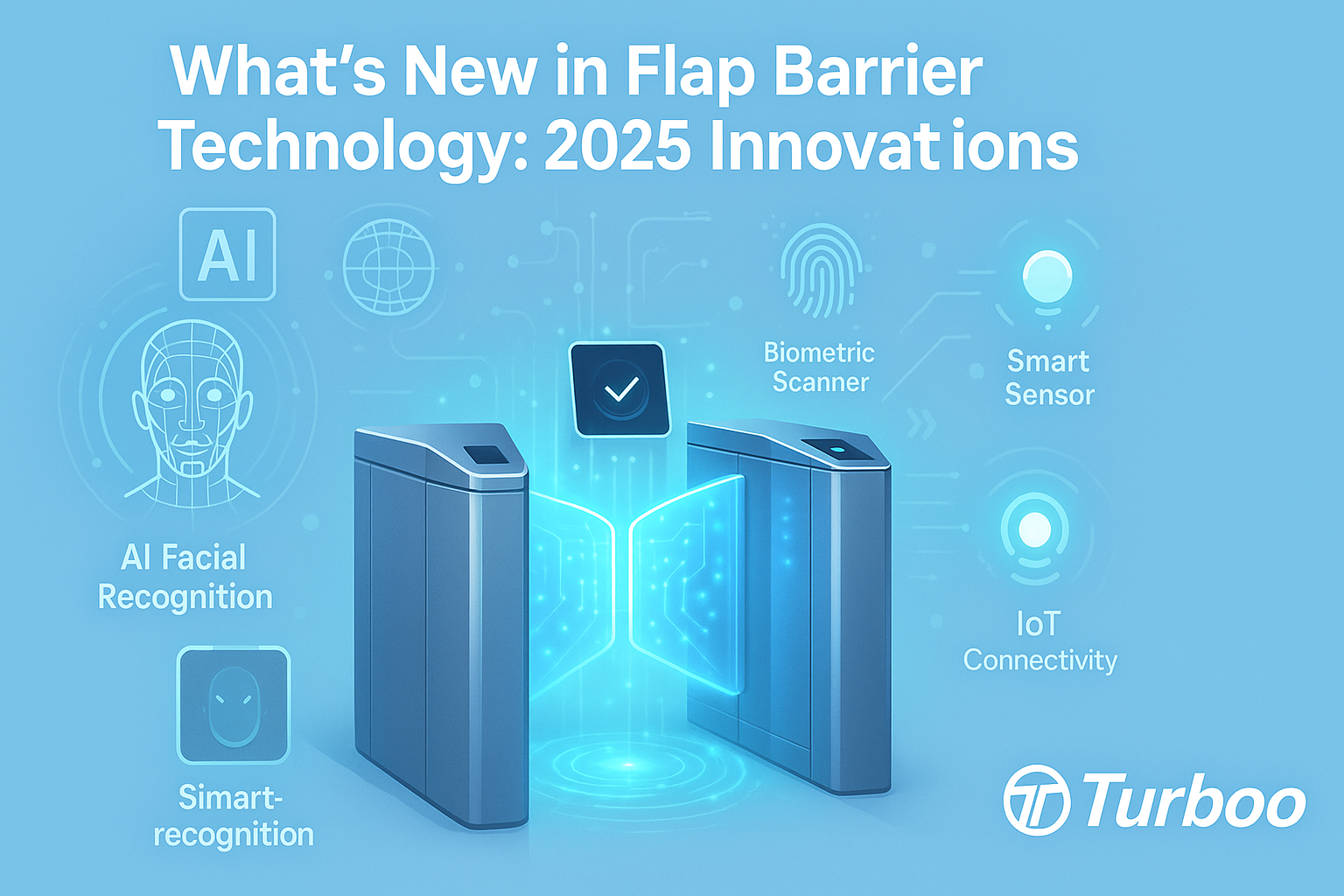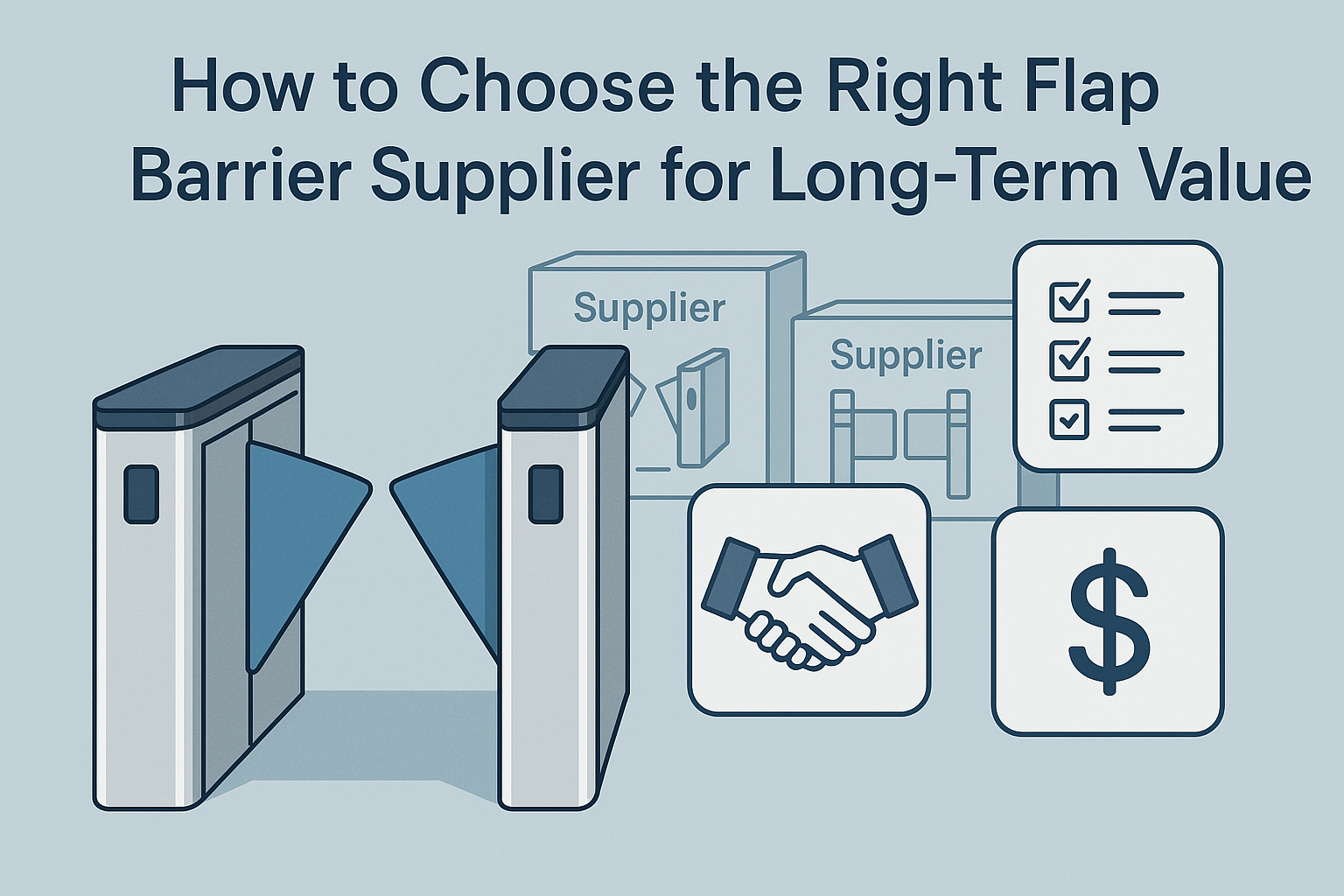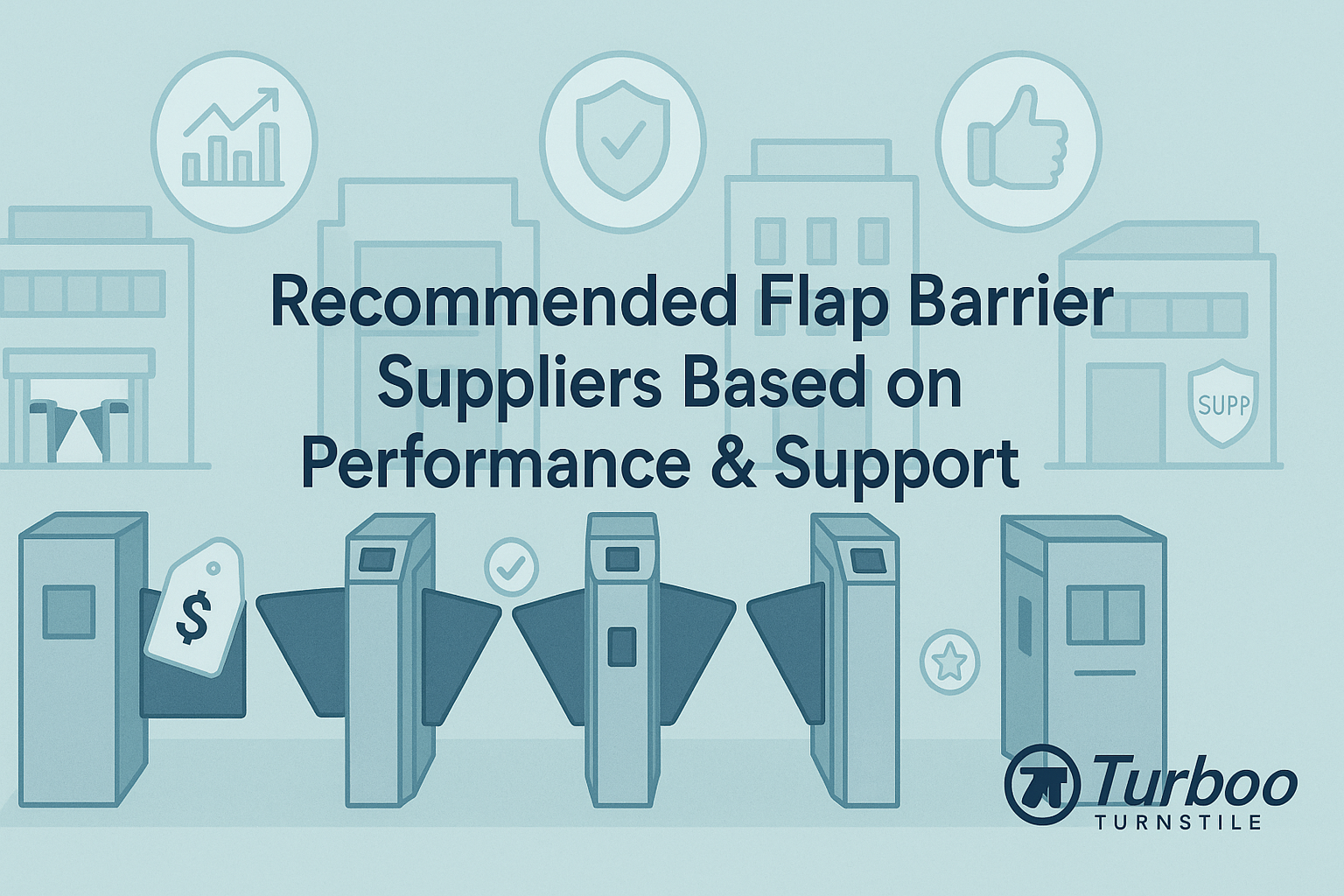What’s New in Flap Barrier Technology: 2025 Innovations


Security systems are changing fast. The days of basic barriers are over. In 2025, flap barriers are smarter, faster, and more connected than ever before. Imagine controlling access in real-time, seeing live entry data, and offering touchless access—all in one system. With the right technology, flap barriers can now do much more than block or allow passage. They become a key part of your building’s security network.
This article will show you the newest features in flap barrier innovation for 2025. You’ll learn how modern barriers save energy, improve safety, and make daily access simpler and smarter. Whether you manage a school, office, mall, or transport hub, these upgrades can help you stay ahead.
Why Flap Barrier Innovation Matters in 2025
Rising Security Expectations
Today’s buildings need better protection. Unauthorized access, health compliance, and crowd control are all real challenges. Security leaders want systems that not only restrict entry but also record data, detect issues, and respond fast. That’s why flap barrier innovation matters. It turns a simple gate into a smart solution that fits with the bigger security picture.
Demand for Smarter, Safer Access
Speed and safety are key. In busy areas, barriers must process many people quickly—but still stop tailgaters or unauthorized users. In sensitive zones, systems must check credentials and detect threats. Smart flap barriers in 2025 can do all this. They use real-time data and advanced logic to keep access smooth and secure.
Future-Proofing Your Facility
Technology moves fast. If your security system falls behind, upgrades get harder and more expensive. Choosing flap barriers with future-ready features means your investment lasts longer. Features like cloud updates, IoT support, and modular hardware ensure your barrier grows with your needs. That’s smart planning for any facility.
Faster and Smarter Flap Barrier Processing
Upgraded CPUs and Controllers
Flap barriers in 2025 now include faster internal processors. These advanced CPUs make decisions in milliseconds. That means quicker access approvals, faster opening times, and smoother flow during peak hours. With more power inside, the system can handle multiple inputs—like face scans, badges, and sensor data—all at once.
Speedier Access Recognition
Old systems had delays. You’d swipe, then wait a second or two. New systems react instantly. They read credentials and open within half a second or less. This reduces line buildup and improves the user experience. The upgrade is especially helpful in high-traffic places like stations and office lobbies.
Multi-User Flow Handling
In 2025, smart flap barriers can now track more than one person at once. Advanced sensors and software recognize different users walking in a group and process each correctly. This feature lowers the chance of tailgating while keeping the line moving. It also makes the system more accurate for real-world use, where perfect spacing doesn’t always happen.
Energy Efficiency and Eco-Friendly Features
Low-Power Standby Modes
Energy use matters. New flap barrier designs come with energy-saving modes. When no one is nearby, the system switches to standby, using minimal power. It wakes up instantly when someone approaches. This feature lowers operating costs and supports eco-friendly building goals.
Smart Sensors That Reduce Usage
Some systems now include motion sensors that trigger only when needed. If no one is entering or exiting, the barrier stays idle. These sensors work with smart software that adapts to your facility’s schedule and flow patterns. This helps reduce wear and saves energy at the same time.
Green Materials in Barrier Design
Modern flap barriers also focus on sustainable materials. You’ll find designs using recycled metal, low-impact plastics, and coatings that resist corrosion without toxic chemicals. These materials last longer and lower the product’s environmental footprint—an important point for facilities aiming for LEED or ESG goals.
Flap Barriers With IoT and Cloud Connectivity
Real-Time Monitoring from Anywhere
One of the biggest flap barrier innovations in 2025 is the ability to monitor access systems remotely using IoT technology. Internet-connected barriers now send real-time data to security dashboards, letting managers track entries and system status from a phone, tablet, or PC. This is especially useful for multi-site operations or off-hours monitoring.
Facility teams can now check who entered, at what time, and through which gate—all in real time. If there’s a problem, like a jam or power issue, the system sends alerts immediately. This rapid awareness helps resolve issues quickly and boosts overall building security.
Live Access Logs and Alerts
With cloud integration, flap barriers can now store and share access logs instantly. These logs include user credentials, timestamps, direction of entry, and even the method used—whether a card swipe, mobile scan, or face ID. If someone tries to force entry or tailgate, the system sends an alert to the control room.
Security staff no longer have to manually check entries or run reports at the end of the day. Instead, automated reports can be emailed or downloaded any time. This data helps improve traffic flow, spot security trends, and resolve disputes about building access.
Cloud Updates and Remote Diagnostics
Cloud-based flap barriers also receive software updates without downtime. In the past, updating firmware required a site visit or manual upload via USB. Now, vendors can send system updates directly over the internet. These updates can fix bugs, add new features, or improve performance without disrupting daily use.
Remote diagnostics is another benefit. If a barrier malfunctions, vendors or facility IT teams can access system logs and performance data online. This saves time, reduces the need for on-site visits, and helps fix problems before they lead to system failure. It also makes predictive maintenance more accurate.
Safety Upgrades for 2025 Systems
Anti-Tailgating Logic
Unauthorized users sometimes try to slip through after someone else has gained access. This is known as tailgating. In 2025, smart flap barriers use anti-tailgating technology to detect and stop this. With improved infrared and laser sensors, the system now counts individuals and stops the flaps from closing or staying open if it senses more than one person.
Anti-tailgating logic also helps reduce internal threats. It ensures that only approved users enter, even in high-speed traffic environments. When combined with real-time alerts, this feature significantly improves entry control without slowing down traffic.
High-Precision Sensors
Sensor accuracy has improved in 2025. Older systems sometimes failed to detect fast movement or smaller individuals. New sensors are more sensitive and scan multiple zones at once. They can detect partial entries, fast motion, or reverse direction movement—giving the system better awareness of human behavior.
This upgrade means fewer false triggers and more reliable access. It also improves safety, especially in environments with children, elderly, or disabled users. By detecting movement precisely, the system avoids accidental closures or false alarms.
Emergency Unlock Systems
Modern flap barriers now include better emergency response features. In case of a fire alarm or power loss, the barriers automatically open or retract to let people pass safely. These systems comply with local safety laws and improve evacuation planning.
Some models also feature override buttons or integration with building management systems. When triggered, these systems bypass standard access rules to let everyone exit quickly. They also log these events for later review, which helps with compliance reporting.
Advanced Biometric and Mobile Integration
Facial Recognition at the Barrier
Biometric access is no longer just for high-security sites. In 2025, flap barriers commonly include facial recognition systems. These units scan a user’s face and grant or deny entry instantly. With AI-assisted facial databases, recognition is fast and reliable—even in changing light or crowded environments.
This technology reduces the need for access cards or keypads. It also minimizes the risk of stolen credentials or lost IDs. Many systems now store encrypted facial data in secure servers and comply with data privacy standards to ensure safe usage.
Mobile Badge and QR Code Access
Another rising trend is mobile access. Users can now scan a QR code or use a digital badge stored in their phone to pass through a barrier. These credentials can be issued and revoked remotely, making them ideal for temporary workers or visitors.
Mobile access also simplifies user management. There’s no need to print ID cards or worry about key fobs. Admins just email a link or send a code. Most systems include mobile SDKs to integrate with your own employee or visitor apps.
Touchless Access Control Compatibility
Hygiene concerns remain important. Touchless systems help reduce the spread of germs and make access more comfortable. Flap barriers now pair with touchless readers, wave-to-open sensors, and even voice commands.
This is especially useful in healthcare, public transport, and education settings. It also adds convenience for users carrying bags, pushing carts, or unable to use keypads. Touchless integration not only improves accessibility but also supports modern facility health standards.
New Designs and Materials for Better Performance
Slimmer Frames for Compact Spaces
As more buildings incorporate security barriers, space becomes a concern—especially in retrofitted or older buildings. That’s why one major flap barrier innovation in 2025 is compact design. New barriers feature slimmer frames without sacrificing strength or speed. These narrow units fit into tighter lobbies, hallways, or entry zones while still offering the full functionality of larger systems.
Smaller footprints mean more lanes in the same space, which helps high-traffic buildings move people faster. It also improves aesthetics, allowing flap barriers to blend into modern or minimalist architecture without looking bulky or industrial.
High-Durability Coatings
Durability is key for any access control system. In 2025, vendors are using tougher coatings on flap arms and housing materials. Powder-coated stainless steel and anodized aluminum are now common, offering strong resistance to scratches, weather, and corrosion. This extends the system’s life, especially in outdoor or semi-outdoor settings like parking garages and transit terminals.
High-touch parts are also being treated with antimicrobial coatings. These surfaces help reduce germ buildup, making the system more hygienic for shared use. Combined with regular cleaning protocols, this improves health safety and reduces wear-and-tear from harsh disinfectants.
Transparent Flaps and LED Feedback
Flap design itself has improved too. Some systems now use transparent polycarbonate flaps, which are stronger, lighter, and more visually open than traditional metal. These flaps don’t block sightlines, which is useful for front desk staff or surveillance cameras monitoring access points.
LED lighting has also become more common. Lights on the barrier housing or flaps now indicate system status—green for open, red for closed, blue for standby, and so on. This visual feedback helps users understand the system instantly, reducing confusion and preventing access delays.
Less Maintenance, More Reliability
Self-Calibrating Mechanisms
One of the key upgrades in 2025 is self-calibrating mechanisms. In older systems, flap alignment and motor tension had to be adjusted manually. Today, new barriers come with built-in sensors that automatically recalibrate after a certain number of cycles or when changes in movement are detected.
This reduces technician visits and keeps the system running smoothly. Facilities with high foot traffic benefit the most, since consistent use can cause drift or loosened fittings over time. With self-calibration, the barrier corrects these issues on its own, minimizing service downtime.
Modular Parts for Quick Swap
Maintenance has also gotten easier thanks to modular design. Many 2025 flap barrier models are built with quick-swap components. That means if a motor, flap, or controller fails, it can be replaced individually without removing the whole unit.
This saves time and lowers maintenance costs. On-site staff can even handle simple swaps themselves after minimal training. Some vendors also include built-in diagnostics that tell you which module failed, guiding technicians directly to the issue without lengthy inspections.
Predictive Maintenance via Sensors
Smart sensors now collect data during every use—movement speed, motor temperature, flap resistance, and more. When something starts to deviate from the norm, the system sends alerts to maintenance staff. This approach, known as predictive maintenance, prevents breakdowns before they happen.
For example, if a motor shows signs of stress or a sensor detects repeated failed entries, the system can schedule maintenance automatically. This avoids unplanned downtime, improves safety, and keeps long-term costs down. It’s another reason why 2025’s flap barrier innovations are a major step forward.
Practical Steps for Facility Managers
Audit Current System Weaknesses
Before jumping into an upgrade, it’s important to understand your current system. Walk through your access points and look for signs of aging—slow flap movement, misreads, or frequent service calls. Talk to users and guards. What frustrates them? Where do delays happen? This info helps you decide what upgrades to prioritize.
Consider checking your existing system’s specs and comparing them to what’s available now. You might find your units lack features like mobile access or IoT support, which are now becoming standard.
Build Tech-Ready Upgrade Plans
With your audit done, plan your next steps. Consider starting with high-traffic or high-risk entry points. Look for systems that offer backward compatibility so they work with your existing access control software.
You don’t need to upgrade every barrier at once. Many vendors offer phased upgrade plans or modular units that can be expanded later. Be sure to ask about future tech options like integration with cloud platforms or biometric readers.
Also, talk to your IT team. Upgrading to smart barriers means integrating with your network. Plan for secure Wi-Fi or LAN access, server compatibility, and data privacy compliance.
Choose Vendors Offering Future-Ready Features
Not all vendors keep up with trends. Before purchasing, look for providers that already support features like cloud diagnostics, touchless entry, or IoT-based access. Ask if they offer system demos or case studies. Review their upgrade history. Do they release firmware updates regularly?
Visit their 2025 trends page and compare options side by side. Strong vendors also offer training and long-term support—key for making your upgrade smooth and successful.
Comparing 2025 Features to Past Models
What’s Improved Since 2020
If you’re still using flap barriers installed before 2020, you’ll notice big differences in the latest technology. Older models often relied on basic mechanical systems with limited digital integration. Their sensors were less accurate, they lacked remote connectivity, and access was primarily card-based.
In contrast, flap barrier innovation in 2025 includes smarter control boards, real-time data streaming, and multiple access types including face ID, mobile badges, and QR codes. Reliability has improved, response times have decreased, and maintenance is now more predictive than reactive.
These upgrades aren’t just technical—they affect everyday use. Users now experience fewer delays, higher success rates when scanning credentials, and improved safety. Security staff enjoy easier management, quicker diagnostics, and better insights from analytics tools.
Value Gains from Modernization
Upgrading to newer flap barrier technology isn’t just about being modern—it’s about improving your building’s efficiency, security, and user satisfaction. With fewer breakdowns, faster entries, and better control, facility teams spend less time on troubleshooting and more time improving operations.
Over time, the return on investment becomes clear: reduced labor costs, lower energy usage, fewer repairs, and improved safety records. Plus, the ability to add new features via firmware means the system stays up-to-date without full hardware replacements.
Real-World Use Cases of New Flap Barrier Technology
Office Complex with Facial Access and IoT Monitoring
In a large office park, the property manager installed smart flap barriers equipped with facial recognition and IoT dashboards. Employees check in using face scans that sync with the company’s HR system. The IoT platform shows live occupancy per zone and alerts security if anyone tailgates or uses expired credentials.
This setup reduced badge-related issues by 70% and provided detailed analytics for managing foot traffic. The property team can now adjust cleaning and HVAC schedules based on real-time usage data, cutting overhead costs while improving comfort and safety.
Transportation Hub Using Anti-Tailgating and Cloud Logs
A busy metro station added anti-tailgating flap barriers to control platform access. The barriers are integrated with the transit card system and cloud-based logs. If someone forces entry or follows closely behind another passenger, the system alerts central command and blocks the flap briefly.
These smart features helped reduce fare evasion by 40% and provided real-time visuals to security teams across the city. Cloud logging also made incident reporting faster and more accurate, which helped during audits and legal follow-ups.
University Campus with Mobile and Biometric Entry
At a growing university, administrators replaced their old turnstiles with 2025-ready flap barriers. Students can now enter dorms, labs, and libraries using either facial ID or their phone’s digital badge. Visitors receive timed QR codes that expire after their approved window.
The new system reduced waiting time during peak class hours and improved data collection for safety planning. In emergencies, staff can unlock all exits instantly from a central dashboard, ensuring a fast and safe evacuation.
Industry Resources to Stay Updated
Keeping up with smart access trends helps you stay ahead. Trusted resources like SecurityInfoWatch and Gartner publish regular updates on smart tech and IoT trends. These sites offer research, comparisons, and advice on integrating security technology into your building systems.
You can also follow flap barrier trends for 2025 or explore future flap barrier tech to see what’s coming next in this fast-moving field.
Next Steps: Bringing Innovation Into Your Facility
Start by listing your current barriers and their limitations. Talk to staff about daily pain points. Then, research vendors that offer systems with cloud features, mobile access, or biometric integration. Ask for demos, compare specifications, and check for compatibility with your building’s existing infrastructure.
You don’t need to upgrade everything at once. Focus on the most-used entry points or highest-security areas first. With each upgrade, you’ll improve safety, save time, and build a smarter facility for the future.
Conclusion and Final Thoughts
The world of security is evolving, and flap barriers are evolving with it. The innovations of 2025 bring smarter access control, better safety features, and cleaner design into one powerful package. From IoT monitoring and facial recognition to energy-saving systems and predictive maintenance, modern barriers help you take control of your facility like never before.
Investing in flap barrier innovation isn’t just about upgrading equipment—it’s about upgrading your whole access strategy. With the right technology, your facility becomes safer, smarter, and more future-ready. Now’s the time to review your setup, explore what’s new, and start planning your next upgrade with confidence.
FAQs
1. What’s the biggest flap barrier innovation in 2025?
IoT connectivity for remote access control and predictive maintenance is one of the top innovations, along with facial recognition and mobile access.
2. Can old barriers be upgraded with new tech?
Some older systems can support partial upgrades like new readers or controllers, but full upgrades are usually needed to support 2025 features like cloud updates and biometric access.
3. Is IoT integration secure for flap barriers?
Yes, as long as the system uses encrypted communication and access protocols. Always check that the vendor complies with cybersecurity standards.
4. Do smart flap barriers need more maintenance?
No. In fact, they often require less thanks to predictive diagnostics and self-calibrating hardware.
5. How can facility teams plan for upgrades?
Start by reviewing current issues, checking vendor roadmaps, and choosing barriers with modular, scalable features for long-term use.












